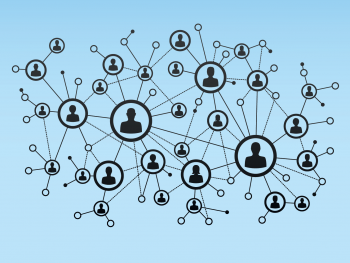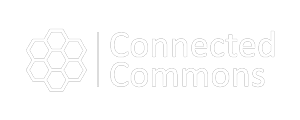Culture and networks reinforce each other in organizations. Culture shapes the beliefs and values in networks. In turn, network interactions create and reinforce culture. This natural interplay between culture and networks isn’t factored into most culture change initiatives—but it is one of the best ways to make culture change actionable.
Over the past decade, my colleagues and I have applied organizational network analysis (ONA) alongside culture assessments across a range of organizations. We have found that network analysis can be used to better understand the cultural values in an organization and identify effective avenues for advancing desired cultural values. We’ve also seen how variation of cultural values can become a source of strength and agility—not a liability. Here’s how our approach works.
1. Drive change through network influencers.
Leaders are not the primary conduit for culture definition and change. But, without knowing a better way, most organizational culture change efforts rely on the top one or two layers of an organization. Often informed by the results of an analysis of culture, such initiatives build consensus in the senior leader core and then cascade new values through the formal reporting structure and communication channels.
When these efforts fall flat, it is likely because the power of informal influence was overlooked. A cultural change program that does not identify people whose opinions matter is unlikely to be effective.
Consider one unit of a well-known manufacturing company. The top two layers of leadership, who would typically be engaged in a culture effort, accounted for only one-third of the cultural influence relations. And some of the top leaders had zero cultural influence! In contrast, the top 50 cultural influencers identified by ONA could reach almost twice as many.
Not only do leaders underestimate the influence of network opinion leaders, but they also do a poor job of knowing who they are to begin with. They are typically less than 50% correct. They often get the top four or five connected people right, but they miss on many others. And, those overlooked people typically influence 60% of the network!
ONA provides a systematic way of knowing whose voice really matters in creating and maintaining the beliefs, values and norms of the organization.
2. Map “contested lines” where disagreement in networks crushes culture change.
Conventional wisdom holds that all members of an organization or unit should hold the same set of cultural values in order to have the alignment needed for agility and execution. Our data show that culture is not uniform, so why try to make it so? More important is the ability to understand variation of cultural values or cultural perceptions. With this information, leaders can promote needed beliefs, values and norms much more effectively.
When we overlay data about employee values on the network, we often see pockets where cultural values are strongly endorsed or weakly embraced in the same unit or location. Or, we see that individuals who advocate most strongly for a given value andthose that are most against it occupy central positions in the network—these influencers tend to balance each other out and make change difficult. This kind of information is not something you would get from a traditional cultural assessment.
In practice, we can use ONA to see who supports or resists a particular position and map that misalignment in a very detailed way. For example, in the graphic below, we’ve mapped two contested issues, driven by misaligned values. Each blue box shows an equal number of network influencers who are for and against, and both misalignments are having a negative impact on more than 50 other people. With this information, you can start to understand why groups are entrenched or resist culture change. More important, you know the people who need to be involved in the conversation to sort things out and make progress.

With ONA, we also gain one more important piece of information. Across the bottom axis on the chart above, we depict the quality of the relationship among the key influencers. This is critical to designing the intervention; in this case, for Misalignment 1, more serious work is required to build trust than for Misalignment 2.
3. Look for positive and negative emotions.
Which brings us to the third point. Culture is not cognitive. Our research shows that emotion (and not logic) is the most important driver of culture change.
Cultural values flow through networks, and they flow exceptionally well when their proponents are strong energizers—individuals who tend to leave others energized and enthused after an interaction. For instance, across a range of organizations we find that the likelihood that any two individuals will share similar cultural beliefs is much higher when they are connected by an energizing tie than when they are connected by only an informational tie. By tapping into the positive emotions that exist in the network, organizations can drive more rapid culture alignment.
One organization we studied was a provider of business services undergoing a major shift in strategy and culture. Leaders knew that there was significant variation in engagement around the change initiative but had trouble understanding why it had taken root in some areas and not in others. A network analysis revealed the important role that first-level leaders played. Whether or not a leader was an energizer explained over 40% of the variation in their subordinates’ adoption of the new cultural values.
We’ve also found that ties built around negative emotions like fear or reluctance are also more likely to transmit cultural values. This makes promoting values around innovation, risk-taking and creativity—which require openness and co-creation—difficult in contexts of negative emotion. But we can measure this too by asking questions like, Who do you not share early stage ideas with? Who do you hold back on ideas until you have a solid plan? With this knowledge, you can work with specific groups or managers—a much easier task than addressing “a culture of fear” as a whole.
Driving cultural change through networks
With the network lens, culture change becomes specific and far more actionable than other approaches to organizational culture change. Targeted interventions within several groups have a greater impact, more quickly, than large-scale, broad cultural efforts. Here are a few examples:
- Knowing where in the network influencers are misaligned on values or priorities and the quality of their relationships allows organizational facilitators or leaders to structure meetings or workshops based on the need.
- Similarly, when leaders know where certain cultural values have already taken root, they can thoughtfully engage sub-networks. Rather than convince others to change, organizations can give energizers a voice to help each other understand the importance of their cultural values.
- Network data also allows leaders to look beyond the typical cultural assessments that report averages on a five-point scale on different dimensions. Looking at the formal organizational structures, many organizations see averages of fours—but the network view typically shows pockets of threes and fives. Treating these clusters as though they are all fours is nonsensical. Leaders can celebrate and propagate what is happening in clusters of the fives. They can work to understand the impediments the threes are facing and do all within their control to remove obstacles. And they could also look for opportunities to pair fives with the threes, creating a pathway for change that is completely invisible with traditional metrics.
A network-based approach to culture change offers many advantages over traditional methods. Instead of pushing culture top-down through formal channels, organizations can drive diffusion of values, beliefs and norms organically and where alignment creates the most benefit.
Learn more about culture and networks in this California Management Review article, Managing Change Through Networks and Values: How a Relational View of Culture Can Facilitate Large-Scale Change. Explore the many ways network analysis can help organizations drive agility and alignment in the blog post, What is Organizational Network Analysis (ONA)? Or, learn more about working with Rob and his team to bring ONA to your change effort.
Share!




 Spark Networks of Innovation with a Culture of Trust
Spark Networks of Innovation with a Culture of Trust
 Rob Cross has studied the underlying network dynamics of effective organizations and the collaborative practices of high performers for more than 20 years. Through research and writing, speaking and consulting, and courses and tools, Rob’s network strategies are transforming the way people lead, work and live in a hyper-connected world.
Rob Cross has studied the underlying network dynamics of effective organizations and the collaborative practices of high performers for more than 20 years. Through research and writing, speaking and consulting, and courses and tools, Rob’s network strategies are transforming the way people lead, work and live in a hyper-connected world.